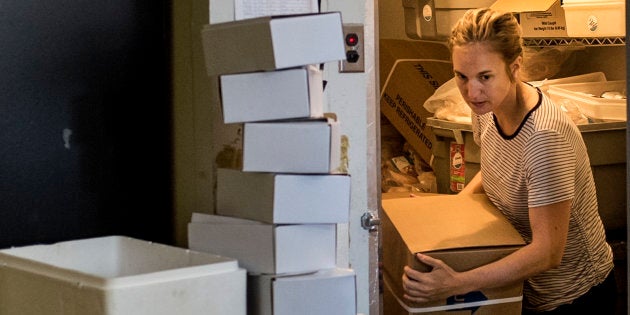

It was in 2017 when Hana Nelson, eight months pregnant and covered in fish slime and scales, was reminded her company definitely needed a new filleting machine. Nelson, an entrepreneur with a background in sustainable development, knew starting and operating her Halifax seafood business Afishionado Fishmongers would be an uphill battle. But looking back, she had no idea how badly even a tiny company like hers would depend on automation to survive.
Even now, as she drops her toddler off at daycare and heads to work — sorting through piles of paperwork, lugging dozens of boxes of largely regionally caught seafood out of a refrigeration unit for weekly deliveries, and occasionally helping her oyster-growing husband land his precious harvest — she encounters the same question: why does even a boutique business like hers need to invest in pricey technology to stay in the seafood game?
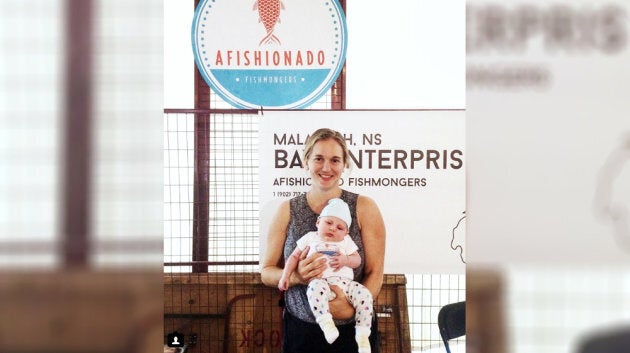
In global fisheries, automation frequently takes the form of intricately engineered stainless steel machines, costing from thousands to millions of dollars, designed to replace dangerous, time-consuming and repetitive tasks. From the ability to distinguish premium product to processing scraps into dog food, automation has grown far beyond the earliest inventions for canning tuna and cutting fish.
According to some observers, the scale to which automation has spread across the industry has barely scratched the surface: one Brookfield Institute report maintains that 62 per cent of current activities in resource-sector jobs, including in fishing, could be automated. ("Can a robot do your job?" — an online tool by the Financial Times and powered by findings from the McKinsey Global Institute — comes to roughly the same conclusion.)
From small businesses like Nelson's to multi-million-dollar global behemoths like New Brunswick's Cooke Aquaculture, most Atlantic seafood companies simply can't make ends meet without automated technology and robots. Seafood buyers demand cheap fish and shellfish. This requires huge volumes of fish processed and distributed as quickly, and at as low of a cost as possible, while still maintaining shelf life.
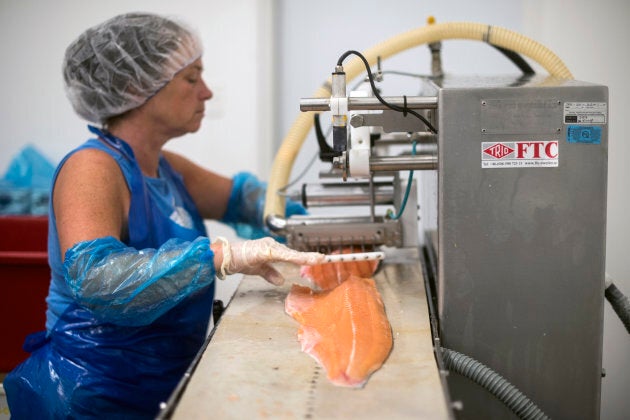
The profits can be enormous — exports of Canadian seafood hit $6.6 billion in 2016 — but so are the risks and potential pitfalls. Global competition, increasingly hard-to-find human labour, and the need to increase volume and cut margins are increasingly pinching seafood buyers and processors from every side.
On the other side of the coin are tiny fishing communities where this state-of-the-art technology is being introduced; communities that are rapidly losing schools and hospitals as populations decamp for urban centers. Fear of losing jobs to automation is real, according to the Brookfield report, although there remains the promise that other better-paying, more-skilled jobs could rise to fill the gap.
"It's so hard to find skilled workers who already know how to fillet fish and get a good yield," says Nelson, who started her company in 2015 to supply and distribute local and sustainable seafood throughout the Maritimes. "When you have automation it's a lot easier to find people, because you can train them in a day."
A scarier threat to fisheries employment than automation, she says, is industry consolidation and the resulting flow of jobs overseas. If a business like hers can't compete on volume and consistency — something she says automated machinery can help with — it won't be able to stay afloat.

Because of an early 1990s moratorium on new groundfish processing licenses in Nova Scotia, Afishionado can't buy or process lucrative wild-caught groundfish like haddock and halibut. Instead, the company relies on the processing and sale of farmed fish like salmon, trout and arctic char to make ends meet. Wholesale customers, like restaurants, and larger buyers are particularly valuable because they place large orders more frequently than home cooks. But, Nelson says, keeping up with the volume can be demanding.
Unfortunately, the automated filleting and pin-boning machines Afishionado took over from the warehouse's previous tenant, a closed-containment salmon farming operation called Sustainable Blue, are old and constantly breaking down.
Filleting by hand requires smooth, accurate cutting along a fish's spine; past tough, rubbery skin; close enough to not waste meat; done one side at a time. Pin-boning — the pulling of tiny, sharp ribcage bones, or pin bones, from salmon sides — is notoriously finicky and laborious and particularly so when done one-by-one with tweezers.
Candace Nickerson, Afishionado's new plant manager, still can't believe how often their machines are on the fritz: because they're a small operation, she struggles to even get the mechanic responsible for fixing them to return her calls.
Sitting behind the long desk and paperwork that lines the walls of her office, she groans that their filleting machine just broke yet again. "This week, we filleted, maybe, 120 fish," says Nickerson. "It took one of my workers all day yesterday and all day the day before, so a straight two days of work just filleting by hand, nonstop."

All this drove Nelson, her newborn in tow, to Boston last March. She went for networking and meetings, but also to track down a new automated filleting machine. Walking the lightly padded blue carpet of Seafood Expo North America, known as the Boston Seafood Show, she scoured rows of rhinoceros-sized gleaming stainless steel contraptions, searching for the right setup. She settled on a $100,000 machine produced by Michigan-based Pisces Fish Machinery.
"One of the reasons we're looking at it, is that it can automatically calibrate between species," she says. "You can set it for rainbow trout, or Arctic char, or even bigger salmon or smaller salmon."
But even though Nelson and her team desperately need the machine, they can't afford it: at least, not on their own. Instead, they're counting on the federal government's new Atlantic Fisheries Fund to help finance and fund the technology. Worth $400 million and set to be distributed over seven years, the fund was announced last year and aimed at supporting innovation, infrastructure development, and partnerships between academia and industry.
We're dealing with a double-edged sword.Wendell Wallach, ethicist
Putting so much emphasis on automation comes with a cost, according to Yale University ethicist Wendell Wallach, author of "A Dangerous Master: How To Keep Technology From Slipping Beyond Our Control."
"We're dealing with a double-edged sword," he says. "Automation can remove us from the drudgery of work, or at least boring, repetitive tasks. But on the other hand you have the challenge that increasing automation can drive down wages and eliminate jobs. Over the breadth of an economy that can be quite destructive."
'Always in hiring mode'
On a summer day in the rural New Brunswick community of St. George, Letsie Blackmore, director of value-added processing at Cooke Aquaculture, walked the processing floor of the company's state-of-the-art farmed salmon processing line. The Canadian-owned firm is one of the world's largest multinational seafood companies, with global sales around $2 billion.
Wearing a white lab coat and earplugs, Blackmore greeted employees, some by name, gesturing towards the noisy, stainless steel machines. This plant's two filleting lines — each of which can cut the sides off 22 salmon every minute — cost $4 million combined.
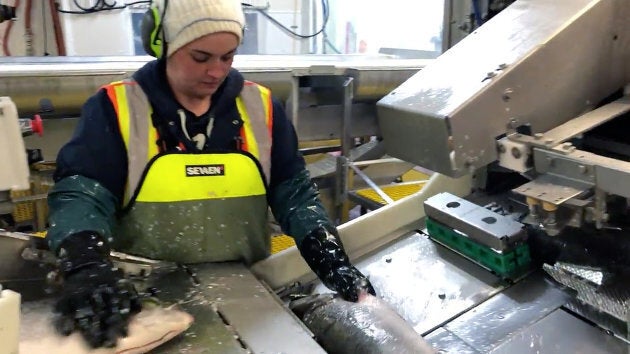
Fish plant work is hard, she says, which is something she knows firsthand. Born in Newfoundland, Blackmore spent her late 20s working at a British Columbia plant gutting, bleeding and washing fish. She gestures at one machine, manned by a single female plant worker who lines up salmon as it cuts off their heads, one at a time, which fall heavily into a bin below. Blood and scales flow in a thick, soupy river towards a grate in the floor.
"Head-cutting by hand is really hard," she says. "You're cutting right behind the collarbone, and you're really having to apply pressure to get that done. If you're doing that for 12 hours a day, your shoulder is not going to last. We took that job from eight people to one person plus a machine, and took that risk to the employee out."
She hated it. Every day, she was like, 'I know what I'm not doing when I get out of school.'Letsie Blackmore
Then, she says, there's the problem of finding labour. The company is "always in hiring mode," she says, and relies on influxes of temporary foreign workers, which they've brought in for a decade, to keep jobs filled. Even her own teen daughter worked at the plant during high school.
"She hated it," says Blackmore. "Every day, she was like, 'I know what I'm not doing when I get out of school.'"
That's a familiar world view for Afishionado's Nickerson, although she sees it differently. Both her grandfathers were fishermen, and everyone in her family except her and one of her brothers has worked on a boat.
"Mom was like, 'Wow, I dropped out of school in Grade 8 to work at a fish plant. You went to school for six years to work at a fish plant,'" says Nickerson. "Coming from the fishing industry, my parents wanted me to be able to work somewhere where I could dress nice every day," she says. "They know how hard their bodies are at their age, so they really don't want me working here, to be honest."
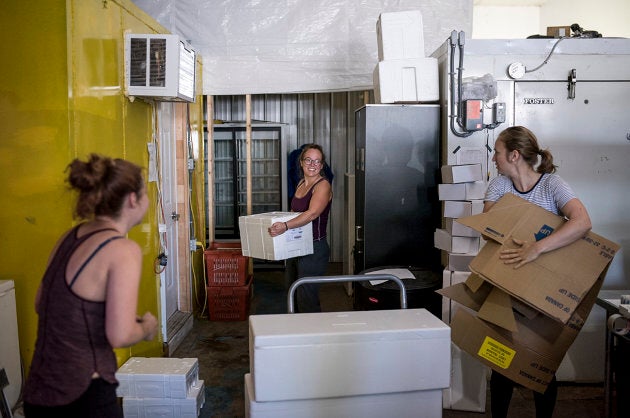
Nickerson says she's trying to help her community hold onto jobs and a historic way of life, both disappearing as large companies like Cooke use economies of scale and cheaper prices to swallow local demand for seafood. If staying afloat means introducing automation so Afishionado can process and sell more fish sourced from and sold near her community, she's all for it.
These days, Blackmore worries about a lot, but particularly about Cooke's plant in Hermitage, N.L., where many plant workers are 55 years old and older. With two people currently working to stack and palletize boxes weighing 65 to 70 pounds each, she's increasingly concerned about risk to those employees. So they're looking at automating that step as well.
Automation must be a huge part of their growing business, she says, "because you're just not getting people into the workforce to do this job anymore."
Now 33 years old, Nelson just ordered a $5,500 handheld pin-boning gadget from the United States; if it works out they'll order a second. And she's still waiting to hear back on her fisheries fund application. That pricey American machine is what Afishionado needs to grow, she says, and automation equals survival.
"Fundamentally, if another, [more sustainable fisheries] model is going to emerge, it's also going to require some scale," she says. "You need to be able to scale. Maybe some people might have issues with that, but I don't."
Also on HuffPost: